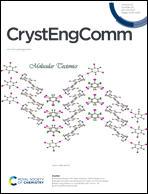Molecular adduct of amantadine ferulate presents a pathway for slowing in vitro/vivo releases and raising synergistic antiviral effects via dual optimization salification strategy†
Abstract
A dual optimization salification strategy has been established for the purpose of taking advantages of the nutrient ferulic acid (FD) to perfect the in vivo/vitro peculiarities of the antiviral drug, namely amantadine hydrochloride (AIN·HCl). The strategy uses FD as the hydrophobic counter anion to react with free alkali (AIN) of AIN·HCl, making the highly soluble AIN·HCl turn into molecular salt with lower solubility. Moreover, the antiviral efficacy is elevated by playing FD's preponderance for possessing assistant antiviral capacity, realizing the synergistically increased antiviral effects of the two ingredients. Taking the strategy as guidance, a new molecular adduct of AIN and FD with isopropanol (IPA) solvent, namely AIN-FD-IPA, is synthesized and characterized as the first antiviral drug-nutrient molecular salt. Single-crystal X-ray diffraction analysis shows that the prepared molecular salt is assembled by strong charge-assisted hydrogen bonds to a sandwich layer structure, which is beneficial toward making the solubility and dissolution rate of the present molecular salt become concurrently down-regulated in comparison with AIN·HCl. Interestingly, the reduced in vitro dissolubility can be converted into a lengthened retention time and enhanced bioavailability in vivo, thus eliminating the side effects originating from the excessive solubility of the native AIN·HCl. More significantly, the molecular salt also exhibits greatly enhanced antiviral effects against the tested viral strains due to the cooperativeness of AIN and FD. Consequently, the current investigation not only supplies a new tactic for traditional antiviral drug AIN·HCl to down-regulate its excessive solubility for reducing the toxic side effect, and simultaneously enhances its antiviral effects via the double optimized hydrophobic molecular salt formation, but also offers an opportunity for phenolic acid nutrients in the application of synergistic antiviral drugs.

- This article is part of the themed collection: Crystal Engineering Techniques


 Please wait while we load your content...
Please wait while we load your content...